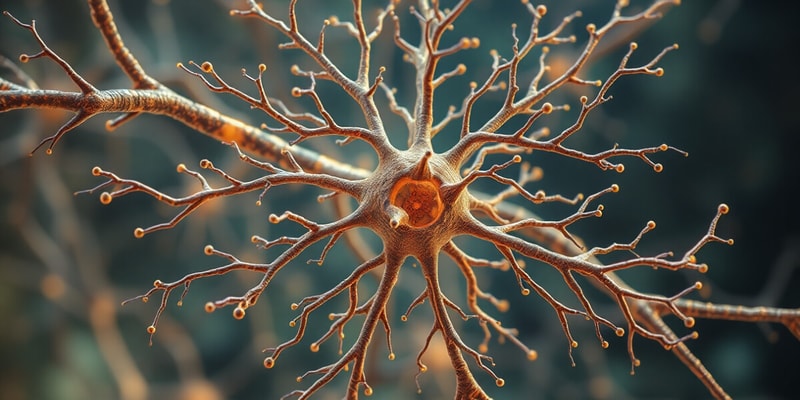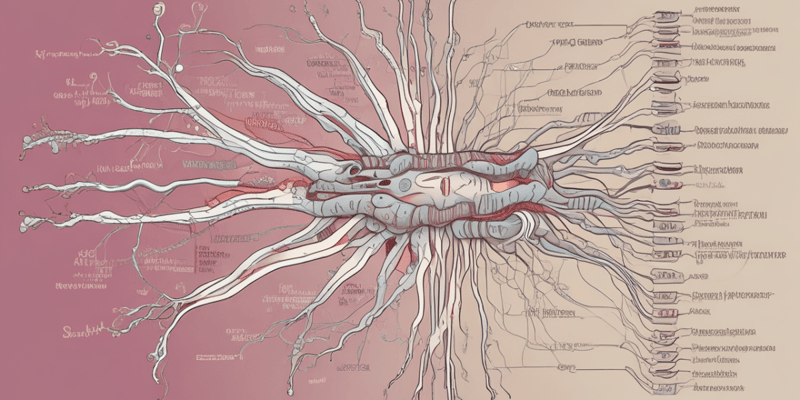Questions and Answers
What role do pre-ganglionic neurons play in the autonomic nervous system?
Which statement accurately describes post-ganglionic neurons?
What best distinguishes pre-ganglionic neurons from post-ganglionic neurons in the autonomic nervous system?
In the structure of the autonomic nervous system, where are pre-ganglionic neurons located?
Signup and view all the answers
What is the primary function of the autonomic nervous system's ganglia?
Signup and view all the answers
Which neurotransmitter is primarily associated with the Peripheral Nervous System?
Signup and view all the answers
Which of the following neurotransmitters is NOT found in the Central Nervous System?
Signup and view all the answers
Which neurotransmitter is commonly associated with the modulation of mood and is found in the CNS?
Signup and view all the answers
What type of neurotransmitter is Substance P classified as?
Signup and view all the answers
Which neurotransmitter primarily facilitates communication in both the Peripheral and Central Nervous Systems?
Signup and view all the answers
Which physiological response is primarily associated with the activation of the parasympathetic nervous system?
Signup and view all the answers
What neurotransmitter is released by the parasympathetic nervous system to exert its effects?
Signup and view all the answers
Which drug is known to enhance gastrointestinal and urinary motility by acting on the parasympathetic nervous system?
Signup and view all the answers
What effect does atropine have on the activity of the parasympathetic nervous system?
Signup and view all the answers
Which of the following types of receptors is NOT associated with the parasympathetic nervous system?
Signup and view all the answers
Which of the following neurotransmitters primarily mediate the functions of the sympathetic nervous system?
Signup and view all the answers
What physiological effect is associated with activation of beta-2 adrenergic receptors?
Signup and view all the answers
Which drug acts as a beta-1 antagonist, helping to reduce heart rate?
Signup and view all the answers
Which of the following effects is NOT typically induced by sympathetic nervous system activation?
Signup and view all the answers
What is one of the primary functions of the sympathetic nervous system related to digestive activity?
Signup and view all the answers
What are the primary functions of pre-synaptic actions in the autonomic nervous system?
Signup and view all the answers
Which of the following describes a key role of post-synaptic actions in the autonomic nervous system?
Signup and view all the answers
In the context of neurotransmitter metabolism, which action is primarily associated with post-synaptic changes?
Signup and view all the answers
What aspect of neurotransmitter management is NOT primarily a function of pre-synaptic actions?
Signup and view all the answers
How do pre-synaptic actions contribute to overall neurotransmitter dynamics?
Signup and view all the answers
Study Notes
Basic Components of the Autonomic Nervous System (ANS)
- Pre-Ganglionic Neurons transmit signals from the Central Nervous System (CNS) to ganglia.
- Post-Ganglionic Neurons are responsible for innervating target organs.
Neurotransmitters in the ANS
- In the Peripheral Nervous System (PNS), key neurotransmitters include Acetylcholine (ACh) and Norepinephrine (NE).
- The Central Nervous System (CNS) uses ACh, NE, Dopamine, Serotonin, GABA, Glutamate, Histamine, and neuroactive peptides such as Substance P.
Parasympathetic Nervous System (PSNS)
- Functions include pupil constriction (miosis), bronchoconstriction, enhancement of gastrointestinal (GI) and urinary functions, and reduction of heart rate.
- The effects of the PSNS result primarily from the release of ACh.
- Receptors involved are Cholinergic Receptors, which can be nicotinic or muscarinic.
- Key drugs that modulate PSNS activity include:
- Bethanechol: Enhances motility in GI and urinary systems.
- Atropine: Acts as an antagonist to PSNS activity.
Sympathetic Nervous System (SNS)
- Functions include pupil dilation (mydriasis), bronchodilation, increased heart rate and contraction, inhibition of GI activity and urination, and elevated blood sugar levels.
- These physiological responses are mediated through the release of norepinephrine and epinephrine.
- Receptors are classified as Adrenergic Receptors, including alpha and beta subtypes.
- Drugs affecting SNS activity include:
- Salbutamol: A Beta-2 agonist that dilates bronchioles.
- Metoprolol: A Beta-1 antagonist that reduces heart rate.
Pharmacology of the ANS
- Pre-Synaptic (Pre-Junctional) Actions involve modifying neurotransmitter synthesis, storage, and release mechanisms.
- Post-Synaptic Actions focus on receptor activation/blocking and neurotransmitter metabolism processes.
Studying That Suits You
Use AI to generate personalized quizzes and flashcards to suit your learning preferences.
Related Documents
Description
This quiz focuses on the basic components of the Autonomic Nervous System (ANS), specifically the roles of pre-ganglionic and post-ganglionic neurons. Understand how these neurons function to connect the central nervous system to various target organs. Test your knowledge of their anatomy and function.




